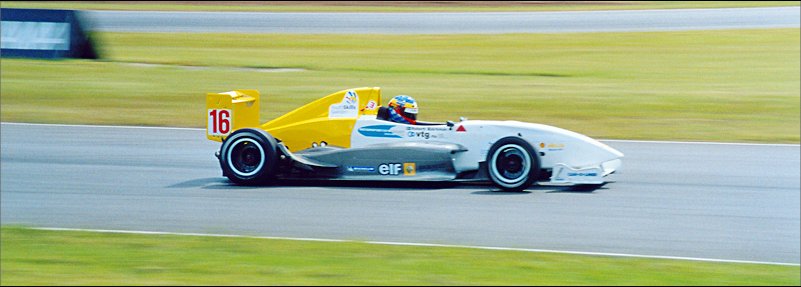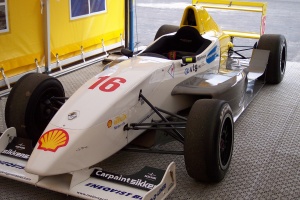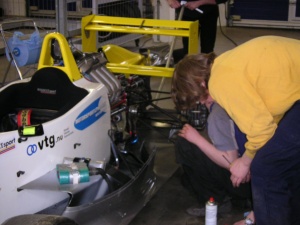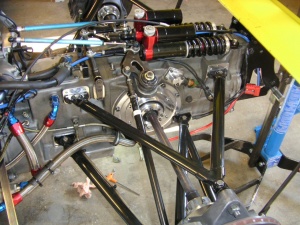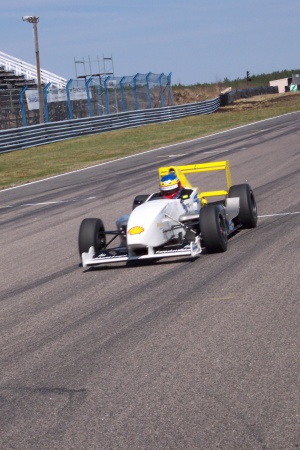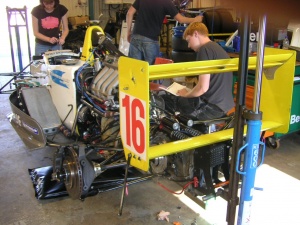Les bases de la mise au point des voitures
By Robert "Moby" Bjorkman
Introduction
Pure physics. This a game of “Where does the weight go?”. Very simply put. When you brake a car at high speed the weight transfers to the front of the car. When you accelerate the weight transfers to the rear. When you turn left the weight goes to the right and the opposite. A racing car is equipped with certain things that make it possible for us to tune the handling of the car.
Anti-roll bars: Alters the front/back distribution of where the weight gets transferred to. So a larger percentage of the total weight transfer will be attracted to the outside wheel of the stiffer end of the car at any moment.
Ressorts: Contrôlent le transfer d'énergie entre les pneus et le châssis.
Ammortisseurs: Contrôlent la vitesse à laquelle le transfer de poids est effectué, mais seulement lorsque la suspension est en mouvement.
Tire and steering angles: Can get the tire to work more efficiently, and also in some cases to stabilise a car.
Brake balance: To balance the car during braking.
Tire pressure: Controls grip, stability, wear and straight-line speed.
Gearing: Making it possible to always have maximum amount of power at all times.
Downforce: Using the air to push the car down to create a sucking effect.
Useful Links
LFS Gear Ratio Calculator:
http://lfs.thefloatingwidget.net/grc.html
F1PerfView:
http://www.xs4all.nl/~rsdi/f1perfview.html
LFS Setup Analizer:
http://forum.rscnet.org/showthread.php?t=157180
User-made setups:
http://setupfield.teaminferno.hu/
Brakes
Max per wheel: Controlling the amount of brake applied to the brake disks on the car.
Brake Balance (front): Amount of brake to go to front or rear of the car.
Suspension
Ride Height Reduction: Controlling clearance to ground and the length of spring travel availble.
Stiffness: Compress and expand to absorb the motion of the wheels.
Bump Damp: How fast or slow the energy of the spring will be absorbed when compressing.
Rebound Damp: How fast or slow the energy of the spring will be absorbed when uncompressing.
Anti Roll: Alters the weight distrubution of the weight that is transferred.
Steering
Maximum Lock: Controls the amount of degrees the tires will turn.
Parallel steer: The amount of angle the rear wheels will follow when steering in certain direction. This could be explained as a dynamic toe-out. The more you steer the more toe-out you will get.
Caster: Controls the angle of the tire when steering. More caster means more stability at high speeds, less caster more stability during low speeds.
Toe-In: Controls the angle of the tire horizontally. This is the direction the wheels are preset to follow. Positive values (/--\) will get you more stability; Negative values (\--/) will get you more turn in capabilities but make the car more nervous.
Final Drive
Differentials: The inner and outer wheels turn along different paths and speed and you can control that with locking or opening the different differentials. Note: Four wheel drive cars have a differential for rear and front and a torque split to decide how to distribute the power to front or rear wheels. Yes you can make the car all rear wheel drive or front wheel drive if you prefer.
Gearing: Adjust the gears so that you don’t have to shift gear in the middle of a corner. Think about if you really need all gears, because shifting takes time.
Final Drive Ratio: Higher value means higher top speed and shorter value means higher acceleration. Just test settings here. The optimal is that at the fastest point on the track the car should hit its peak rpm.
Tyres
Tire Compounds: Softer or harder tires.
Pressure: Controls grip, tire stability and wear. If you have low air pressure you get more grip but if you have more air your car will go faster in a straight line.
Camber Adjust: Controls the angle of the tire vertically. If you have a lot of camber the car will go faster in a straight line due to that there is a lesser tire patch touching the ground. But a lot of camber will also reduce braking and accelerating abilities.
Downforce
The more wing (more angle) of wing you are using the more downforce is created. More downforce means more grip and that grip increases with the amount of speed you are driving. However the grip doesnt come for free. The more wing the more drag is created and you car will be harder to push thru the air meaning less top line speed.
Car Balance
The next step is how we detect what to change, and what not to change. I will show you a corner that will make you understand better.
Entry: You hit the brakes and start to downshift.
Weight: The weight goes to the front end of the car. Your front shocks compress and your rear shocks uncompress.
Apex: You have turned into the corner and released the brake pedal.
Weight: The weight has now transferred to the side of your car. The roll bars do their work here, and the shocks on the side of your car is compressed and on the inside of your car the shocks are uncompressed.
Exit: You start to accelerate out of the corner.
Weight: The weight moves to the rear of the car. The rear shocks compress and your front shocks uncompress.
The conclusion is this when you want to adjust your shock absorbers. These are the things at work during the different weight transistions.
Front Rear Entry: Bump dampening Rebound dampening Mid corner: Roll-bar Roll-bar Exit: Rebound dampening Bump dampening
Simplefied the softer you make a shock absorber the more weight is transferred. The harder you make it lesser the weight is transferred. So if I have a car that is understeering going into the turn I need more weight on the front end. That you can change in two ways either make the front end softer so the front end squats more or loosen the rear rebound damping, so the rear end lifts up more and there by transferring more weight to the front end. If I have an understeering car out of the corner I can make the rear compression damp harder so that less weight is transferred to the rear, and I can change the Rebound dampening in the rear so the front end doesn’t come up so much and there by less weight is transferred. If I have a problem in the corner I can either loosen the rear roll bar if oversteering or soften the front roll bar if understeering.
The dampers are the fine-tuning of a racecar. The big differences are made with spring settings. The springs affect everything since they are the major connection between chassis and tire. The springs work according to the list below.
Softer springs Harder springs + + More grip from tires More responsive handling Less tire wear Produces more heat in tires. - - Higher ride height required Lower grip from tires Less responsive handling More tire wear
The general thesis is that you set the springs pretty hard as it increases stability, driveability and it gets the car pointing in the right direction quicker. When the springs are too hard the car will be very nervous and you won’t get the traction from the tires that’s available. There are also a few other advantages of having stiff springs but that’s a lot of technical stuff so we won’t go into that here. Just remember that if you change spring settings you probably will have to tune the shocks again to get the car balanced. In real life, the lower the car is, the more underground effect and there by more grip is produced. However this is not implemented in LFS as of Alpha S2.
Okay springs are set, the shocks are set, what else? Tires!.Tires is what wins a race. In LFS using the F9 key we can follow our tires temperatures. First we have a few options in the garage under the tyres menu. We can choose compounds. The racing cars have R1 to R4 to choose from. R1 being the one with most grip but with shortest life. R4 being the the one for long distances but with least grip. Using the F9 key after a couple of laps you can see the temperatures of the tires. Blue means that your ties are too cold and red showing that the tires are too warm. Green shows the optimum temperature of the choosen tires. You will also get three temperature readings for each tire. Your aim should be getting the inside and middle temperature the same. Unless you are dragracing. You control these three readings by adjusting the camber.
The objective with camber is to get the tire as much contact with the ground as possible. If you're going in a straight line you don’t need any camber but when you turn the weight transfers to the outside of the corner and the tire only have half the contact patch. What we would like is that the tire is at its optimal angle in the corner to get as much grip as possible. That’s why we have to set the tire angle before hand.
All racing cars racing on normal tracks (not ovals) have negative camber. This get the outside wheels in a corner to have an optimal contact patch with the ground. Oval racing cars only turn one way and with heavy banking they need large amounts of camber on outside wheel and positive camber on inside so the inside tires also have maximum contact patch.
If the temp looks like this you have too much camber.
Outside Middle Inside 70 81 91
If the temp looks like this you don’t have enough camber
90 80 71
If you have too much tire pressure the reading looks like this
80 88 80
Optimal is to have the inside and middle temperatures the same
60 85 85
Quick Reference Page
If your car behaves in any of these ways test the following. I will remind you that these are general suggestions since I don’t know your current setup.
My car understeers into the corner
Soften front com. damp
Soften rear reb.damp
More caster
Softer front springs
Harder rear springs
My car oversteers into the corner
The opposite of the above
My car understeers mid corner
Soften front rollbar
Harder rear rollbar
More camber
My car oversteers mid corner
The opposite of the above
My car understeers out of the corner
Harder front reb. Damp
Harder rear comp.damp
Harder front springs
Less camber
Less caster
My car oversteers out of corner
The opposite of other side
